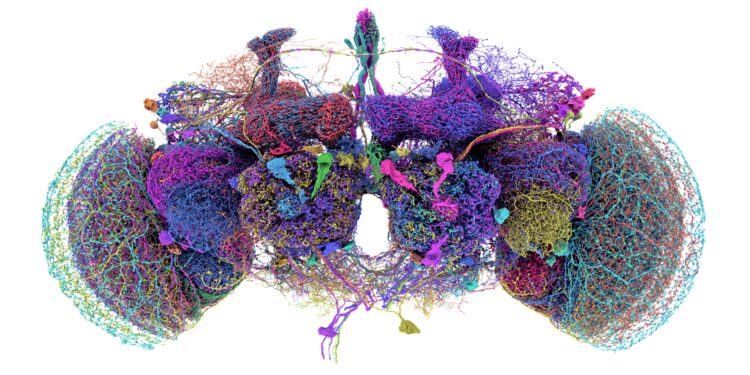This map shows the precise location and arrangement of the 50 largest neurons in the fly brain connectome. These 50, along with 139,205 other brain cells in the brain of an adult fruit fly, were painstakingly mapped by a Princeton University-led team of neuroscientists, gamers and professional tracers. Activity within these neurons (brain cells) determines everything the body does, from sensory perception to decision-making to flight control. Brain cells are connected by more than 50 million connections (synapses). Credit: Tyler Sloan and Amy Sterling / FlyWire / Princeton University
A Princeton-led team of scientists has built the first neuron-by-neuron and synapse-by-synapse road map through the brain of an adult fruit fly (Drosophila melanogaster), marking a major milestone in the study of the brain. This research is the flagship article in the October 2 special issue of Naturedevoted to the new “connectome” of the fruit fly.
Previous researchers have mapped the brain of a C. elegans worm, with its 302 neurons, and the brain of a fruit fly larva, which had 3,000 neurons, but the adult fruit fly is several orders of magnitude larger. complex, with nearly 140,000 neurons and around 50 million synapses connecting them.
Fruit flies share 60% of human DNA, and three out of four human genetic diseases have a parallel in fruit flies. Understanding the brains of fruit flies is a stepping stone toward understanding the brains of larger, more complex species, like humans.
This is a major achievement,” said Mala Murthy, director of the Princeton Neuroscience Institute and, with Sebastian Seung, co-lead of the research team. “There is no other complete brain connectome for an animal adult of this complexity.” Murthy is also the Karol and Marnie Marcin ’96 Professor of Neuroscience at Princeton.
Seung and Murthy of Princeton are co-senior authors of the seminal paper in the Nature issue, which includes a suite of nine related articles with overlapping author sets, led by researchers from Princeton University, the University of Vermont, the University of Cambridge, the University of California at Berkeley, UC-Santa Barbara, Freie Universität-Berlin, and the Florida Max Planck Institute for Neuroscience.
The board was developed by the FlyWire Consortium, based at Princeton University and made up of teams from more than 76 laboratories with 287 researchers from around the world as well as volunteer players.
This image is a video still showing the brain inside an adult fruit fly. Credit: Amy Sterling / FlyWire / Princeton University
Sven Dorkenwald, the lead author of the paper, led the FlyWire consortium.
“What we’ve built is, in many ways, an atlas,” said Dorkenwald, a 2023 doctoral graduate from Princeton, now at the University of Washington and the Allen Institute for Brain Science.
“Just like you wouldn’t want to go to a new place without Google Maps, you wouldn’t want to explore the brain without a map. We created a brain atlas and added annotations for all the businesses, buildings, names of streets Thanks to this, researchers are now equipped to thoughtfully navigate the brain as we try to understand it.
And just like a map that traces every little lane as well as every highway, the fly connectome shows the connections within the fruit fly brain at every scale.
The map was constructed from 21 million images taken of the brain of a female fruit fly by a team of scientists led by Davi Bock, then at the Howard Hughes Medical Institute’s Janelia Research Campus and now at the University from Vermont.
Using an AI model built by researchers and software engineers working with Princeton’s Sebastian Seung, the chunks and blobs of these images were transformed into a labeled three-dimensional map. Instead of keeping their data confidential, the researchers opened their ongoing neural map to the scientific community from the start.
This image shows the complete fruit fly connectome: the 139,255 brain cells in the brain of an adult fruit fly. Activity within these neurons drives an entire organism, from sensory perception to decision-making to flight. These neurons are connected by more than 50 million connections (synapses). A Princeton-led team of gamers, neuroscientists and professional tracers painstakingly mapped the locations and connections of every brain cell, using 21 million images. Credit: Tyler Sloan/FlyWire/Princeton University
“Mapping the entire brain has been made possible by advances in AI computing. It would not have been possible to manually reconstruct the entire wiring diagram. This shows how AI can advancing neuroscience,” said Professor Sebastian Seung, one of the co-leads of the research, Princeton’s Evnin Professor of Neuroscience and a professor of computer science.
“Now that we have this brain map, we can close the loop that which neurons are linked to which behaviors,” Dorkenwald said.
This development could lead to tailored treatments for brain diseases.
“In many ways it (the brain) is more powerful than any human-made computer, but for the most part we still don’t understand its underlying logic,” said John Ngai, director of the BRAIN initiative of the United States National Institutes of Health.
“Without a detailed understanding of how neurons connect to each other, we won’t have a basic understanding of what goes right in a healthy brain or what goes wrong in disease.”
More information:
Neuronal wiring diagram of an adult brain, Nature (2024). DOI: 10.1038/s41586-024-07558-y. www.nature.com/articles/s41586-024-07558-y
Provided by Princeton University
Quote: Researchers map the entire brain of an adult fruit fly for the first time (October 2, 2024) retrieved October 2, 2024 from
This document is subject to copyright. Except for fair use for private study or research purposes, no part may be reproduced without written permission. The content is provided for informational purposes only.



